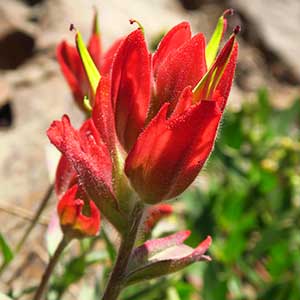Castilleja subinclusa
Castilleja elmeri
Franciscan paint brush, longleaf Indian paintbrush
Elmer's Indian paintbrush, Elmer's paintbrush, Wenatchee Indian paintbrush, Wenatchee paintbrush
solitary or few to many, erect to ascending, often leaning on nearby shrubs (var. jepsonii), unbranched or branched, often with small, leafy axillary shoots, hairs matted to spreading, short and long, soft, mixed with short stipitate-glandular ones.
solitary or few to many, erect to ascending, sometimes slightly curved at base, unbranched, rarely branched, hairs moderately dense, spreading, medium length, soft, mixed with shorter eglandular and stipitate-glandular ones, at least on distal 1/2 of stem.
green, pale gray-green, sometimes dull reddish purple, linear to narrowly, sometimes broadly, lanceolate, 2–10.5 cm, not fleshy, margins plane, sometimes ± wavy, flat or involute, 0(–3)-lobed, apex acuminate to acute;
lobes spreading, linear to short-lanceolate, often arising near mid length, apex acute to obtuse.
green, rarely purple-tinged, linear-lanceolate, sometimes linear or lanceolate, 1.3–6.5 cm, not fleshy, margins plane, flat or involute, entire, apex acute.
3–30 × 1–7 cm;
bracts green or dull purple throughout, or proximally green or dull purple, distally bright red to orange-red, sometimes salmon, orange, or yellow, usually linear to lanceolate, distal sometimes broadly lanceolate to oblong or elliptic, 0(–3)-lobed;
lobes spreading to erect, linear to oblong or triangular, short or medium length, arising near or above mid length, apex acute to obtuse.
2.5–9 × 1.5–3 cm;
bracts red, crimson, scarlet, pink, magenta, red-orange, burnt orange, orange, pale yellow, or whitish throughout, or proximally greenish, distally as stated above, oblong, narrowly obovate, elliptic-oblong, or narrowly ovate, 0(–5)-lobed, rarely with 1 or 2 pairs of short, usually distal lobes;
lobes ascending, lanceolate, very short, arising from distal edge, apex rounded to obtuse.
0 mm.
curved proximally, straight to slightly curved distally, 25–57 mm;
tube 15–29 mm;
beak subequal to or exceeding calyx but abaxial lip, beak, and often part of tube usually exserted out abaxial cleft;
beak adaxially green, yellow-green, or yellow, 13–21 mm, margins red, orange, or yellow;
abaxial lip green, yellow, reddish, blackish, or deep red-purple, reduced, protuberant, forming a platform, 1–2 mm, 5–25% as long as beak;
teeth ascending, green, purple sometimes with reddish tip, yellow, or blackish, 0.5–1 mm.
straight, 20–33 mm;
tubes 13–18 mm;
beak, and sometimes abaxial lip, partially to fully exserted;
beak adaxially green to yellowish, 8–15 mm;
abaxial lip incurved, green, thickened, 2–3 mm, 20–33% as long as beak;
teeth ascending or incurved, green, 0.5–1 mm.
proximally pale green, rarely pale purple, distally bright red or red-orange, rarely orange or yellow, or bright red or red-orange throughout, 20–42 mm;
abaxial clefts 13–27 mm, adaxial 7–17 mm, abaxial 40–70% of calyx length, adaxial 12–33% of calyx length, deeper than laterals, lateral 0–7.5 mm, 0–35% of calyx length;
lobes linear to narrowly triangular, strongly curved away from stem proximally and distally obviously curved toward stem, apex acute to acuminate to obtuse.
proximally green to pale green, distally colored as bracts, 15–25 mm;
abaxial and adaxial clefts 5–14 mm, 33–50% of calyx length, deeper than laterals, lateral 1–4 mm, 6–20% of calyx length;
lobes lanceolate to narrowly triangular, apex rounded to obtuse.
= 24, 48, 72, 96.
= 48.
Castilleja subinclusa
Castilleja elmeri
Varieties 3 (3 in the flora).
Castilleja subinclusa is divided into three varieties with somewhat discontinuous ranges. Identification of the varieties is often difficult when comparing only a single trait but is more easily accomplished when the characters are considered in a suite. The three varieties are also separable by range and habitat.
(Discussion copyrighted by Flora of North America; reprinted with permission.)
The bracts and inflorescences of Castilleja elmeri can be red, crimson, scarlet, pink, magenta, red-orange, burnt orange, orange, pale yellow, or whitish. While the coloration is highly variable between local populations, it is usually uniform and consistent within them. It is found primarily in the Wenatchee Mountains of Washington, where it is often on serpentine, but it ranges northward in the Cascades into extreme southern British Columbia, apparently on non-serpentine substrates. Hybrids with C. miniata var. miniata, C. parviflora var. albida, and C. thompsonii have been found in the eastern Cascades of Washington, and a similar hybrid swarm with C. thompsonii is reported from southern British Columbia.
(Discussion copyrighted by Flora of North America; reprinted with permission.)
1. Corolla beaks adaxially bright yellow, sometimes greenish yellow near apex, margins yellow, rarely orange or red, strongly contrasting with color of calyces; stems and leaves greenish, sometimes dull reddish; lateral calyx clefts 0–4 mm; coastal scrub communities; coastal c California. | var. franciscana |
1. Corolla beaks adaxially green to yellow-green, rarely yellow, margins red to orange, rarely yellow, not strongly contrasting with color of calyces; stems and leaves greenish, pale gray-green, or dull reddish; lateral calyx clefts 3–7.5 mm; dry, sandy or rocky slopes, desert scrub, foothill woodlands, chaparral, brushy openings in pine-oak woods; w foothills of Sierra Nevada in c California or sw California. | → 2 |
2. Stems and leaves greenish, sometimes dull reddish; bracts (0–)3-lobed; brushy openings in pine-oak woods; mostly in w foothills of Sierra Nevada in c California. | var. subinclusa |
2. Stems usually dull reddish; leaves usually pale gray-green to ± ash-colored; bracts 0(–3)-lobed; dry, sandy or rocky slopes, desert scrub, foothill woodlands, chaparral; sw California. | var. jepsonii |
